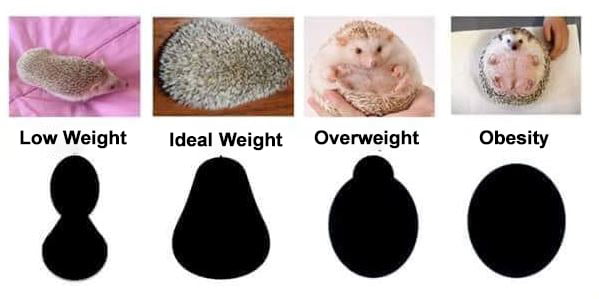How Much Should Your Hedgehog Weigh? (Weight chart included)

The standard hedgehog weight varies between 300 and 500 grams, while there are other smaller ones that weigh an average of 250 grams, and other ones that weigh more than 600 grams.
How do you know if your hedgehog is overweight?
In general, a hedgehog with an ideal weight should be pear-shaped. If you notice your hedgehog is very thin or obese (ball shape), you should go to a veterinarian for exotic animals, or consult any veterinarian in your region, because if overweight or malnutrition persists, another more serious pathology can come along.

How quickly do hedgehogs gain weight?
Younger hedgehogs can quickly gain weight ready for hibernation, between 10 and 20 grams per night.
Hedgehogs usually eat much more than they will need to survive. This is due to their preparation for hibernation where they will need to maintain a minimum weight in order to survive.
In three weeks they can duplicate their weight. An adult hedgehog can weigh more than two pounds, the very heavy ones up to 1500 grams. In one night they can consume 150 grams of meat and drink more than 50 grams of liquid.
What kind of food can you feed your hedgehog?
Hedgehogs (especially African ones), which are usually kept as pets in the home, need a low-fat diet that is very balanced in terms of protein and fiber.
Special foods for hedgehogs are beginning to appear on the market but are currently not well balanced and are not recommended. The best thing to feed a hedgehog at home is a well-balanced high-end cat food.
It should be noted that balanced high-end cat food is expensive but usually lasts a long time and in the long run, is the best food you can give the hedgehog because of its protein and fiber content. From time to time you could give them wet cat food, high-end cat food as well.
Hedgehogs are insectivorous animals by nature, many hedgehog owners feed their hedgehogs on any insects they encounter, especially crickets and snails, although there is a risk of transmitting a parasite to the hedgehog by doing so.
You can feed the hedgehog with chicken, turkey, boiled egg, salmon and tuna but without salt or sauce. Among the fruits and vegetables you can eat are: apple, pear, banana, strawberries, melon, carrot (cooked), broccoli, potatoes (cooked). Always in small quantities.
How much food and what time can the hedgehog eat?
For hedgehogs, the ideal time to eat is always in the evening night and the next morning you should remove all the food that has not been eaten.
The recommended amounts are more or less, 2 big spoonfuls of dry cat food, 1 teaspoon of fruits or vegetables, 1 big or 2 medium insects. All this per day and without exceeding much.
Why do hedgehogs become obese?
Like humans and other animals, hedgehogs become obese. It seems that the causes are generally summarized in the following two points.
- Eating too much high-fat food
- lack of exercise
There are many hedgehogs that have an unbalanced diet, if they like high fat food they will eat too much of it, because it is natural for hedgehogs to maintain high levels of fat in their body in their natural environment in order to survive the hibernation process.
Also, hedgehogs in captivity are more prone to lack of exercise than wild hedgehogs. A wild hedgehog spends most of the day in constant motion looking for food, they can run and walk several kilometers every day.
Compared to hedgehogs that live in the wild, it may be inevitable that hedgehogs that are kept under human care will be able to get a lot of exercise, as they will have food within reach without making any effort.
That is why it is important that the owner takes responsibility for the hedgehog’s physical condition in order to avoid obesity.
Prohibited foods for hedgehogs
The following foods are totally banned for hedgehogs: sugars, chocolate, raw carrots, citrus fruits, onions, garlic, tomatoes, dairy products and anything derived from prefabricated foods such as hamburgers.
If the hedgehog is small or is a pregnant female, it will be put in the balanced feeder, and it will have the feeder always full.
The water should be clean and fresh daily. Remember that water is as important or more than food
Hedgehog weight chart in grams
| Weight | Approximate age | info |
| 10-25 g | 0 days | Birth weight white spines, pink skin |
| 30-50 g | about 1 week | Single dark spines |
| 60-80 g | approximately 2 weeks | Eyes and ears open, the first fluff grows |
| Up to 90 g | Target increase: 4-6 g per day for pets | |
| From 90 g | Target increase: 9-11 g per day for pets | |
| 100-130 g | about 3 weeks | Teeth poke through |
| 140-180 g | about 4 weeks | first outdoor walks and first solid food |
| From 250 g | Put the foster animals in the open-air enclosure when the weather is good (open-air enclosure still necessary for some time in spring if the weight of the find was lower) | |
| 250-350 g | about 6 weeks | Self-employed loners |
| 400 g | When it is cold (no frost!) Put the foster animals into the outdoor enclosure only now | |
| 500 g | Target weight November, in November lighter hedgehogs need to be cared for. Target increase: 9-11 g per day for foster animals |
|
| 600-700 g | Hibernation weight for young hedgehogs | |
| 750 g | Max. a year | Targeted maximum weight for young hedgehogs during care (heavier hedgehogs are too fat!) |
| 800 g | ||
| 800-1500 g | Grown up | Normal weight for adult hedgehogs |
| 900-1500 g | Hibernating weight for adult hedgehogs |
Can you keep two small hedgehogs of the same weight together?
Small hedgehogs and hedgehog brothers up to about 300 g can stay together, except if one turns out to be a troublemaker and blows the whistle or bites the other one; then the small bully has to be separated.
What is the ideal weight for a hedgehog to survive hibernation?
To successfully overcome a period of hibernation, a hedgehog needs to obtain a minimal pre-hibernation body weight and a minimum percentage of total body fat, in special slow-moving brown fat.
To have a realistic prospect of surviving hibernation in it, a hedgehog must have a minimum of 650 g, with a rounded (spherical) end, that is a satisfactory weight for its size.
Helping wild hedgehogs according to their weight
Hedgehogs have territories of up to one square kilometer and walk an average of 3 to 5 kilometers at night. Originally the hedgehog, or more precisely the Central European brown-breasted hedgehog (Eraceus europaeus) lived in light deciduous and mixed forests, on the edges of forests and in bushes.
Due to the intensification of land use, it was increasingly displaced into the parks and gardens of the settlements. The twilight and nocturnal animals spend the day in changing “day nests” under bushes or in piles of leaves.
Hedgehogs are lonely nocturnal animals and can generally only be found in pairs during the mating season. During the day hedgehogs sleep in their shelter under the bushes or in the tall grass.
Their active phase, in which they look for food, only begins at sunset. On a night excursion, hedgehogs can easily cover up to two kilometers but usually move slowly. If they are disturbed, they move away quickly.
In general terms, the hedgehog does not travel to change places frequently, Hedgehogs stay true to their location, which means they stay in the same area during their lifetime if possible. When it gets cold at the end of October or the beginning of November, the hedgehogs go into hibernation.
Hedgehogs prefer structurally rich habitats with changing vegetation: Woods, even those with dense undergrowth, are just as important as open areas (ie without woody trees) with tall grass. Such varied habitats offer a multitude of sleeping places and food sources.







